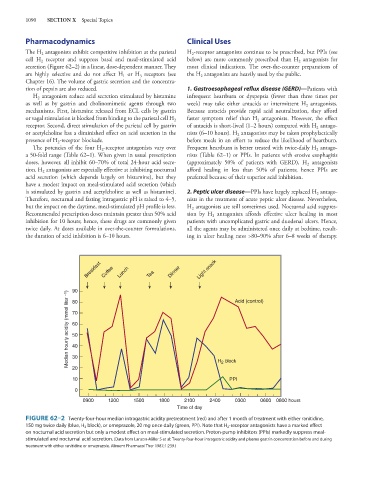Page 1104 - Basic _ Clinical Pharmacology ( PDFDrive )
P. 1104
1090 SECTION X Special Topics
Pharmacodynamics Clinical Uses
The H antagonists exhibit competitive inhibition at the parietal H -receptor antagonists continue to be prescribed, but PPIs (see
2
2
cell H receptor and suppress basal and meal-stimulated acid below) are more commonly prescribed than H antagonists for
2
2
secretion (Figure 62–2) in a linear, dose-dependent manner. They most clinical indications. The over-the-counter preparations of
are highly selective and do not affect H or H receptors (see the H antagonists are heavily used by the public.
1
3
2
Chapter 16). The volume of gastric secretion and the concentra-
tion of pepsin are also reduced. 1. Gastroesophageal reflux disease (GERD)—Patients with
H antagonists reduce acid secretion stimulated by histamine infrequent heartburn or dyspepsia (fewer than three times per
2
as well as by gastrin and cholinomimetic agents through two week) may take either antacids or intermittent H antagonists.
2
mechanisms. First, histamine released from ECL cells by gastrin Because antacids provide rapid acid neutralization, they afford
or vagal stimulation is blocked from binding to the parietal cell H faster symptom relief than H antagonists. However, the effect
2
2
receptor. Second, direct stimulation of the parietal cell by gastrin of antacids is short-lived (1–2 hours) compared with H antago-
2
or acetylcholine has a diminished effect on acid secretion in the nists (6–10 hours). H antagonists may be taken prophylactically
2
presence of H -receptor blockade. before meals in an effort to reduce the likelihood of heartburn.
2
The potencies of the four H -receptor antagonists vary over Frequent heartburn is better treated with twice-daily H antago-
2
2
a 50-fold range (Table 62–1). When given in usual prescription nists (Table 62–1) or PPIs. In patients with erosive esophagitis
doses, however, all inhibit 60–70% of total 24-hour acid secre- (approximately 50% of patients with GERD), H antagonists
2
tion. H antagonists are especially effective at inhibiting nocturnal afford healing in less than 50% of patients; hence PPIs are
2
acid secretion (which depends largely on histamine), but they preferred because of their superior acid inhibition.
have a modest impact on meal-stimulated acid secretion (which
is stimulated by gastrin and acetylcholine as well as histamine). 2. Peptic ulcer disease—PPIs have largely replaced H antago-
2
Therefore, nocturnal and fasting intragastric pH is raised to 4–5, nists in the treatment of acute peptic ulcer disease. Nevertheless,
but the impact on the daytime, meal-stimulated pH profile is less. H antagonists are still sometimes used. Nocturnal acid suppres-
2
Recommended prescription doses maintain greater than 50% acid sion by H antagonists affords effective ulcer healing in most
2
inhibition for 10 hours; hence, these drugs are commonly given patients with uncomplicated gastric and duodenal ulcers. Hence,
twice daily. At doses available in over-the-counter formulations, all the agents may be administered once daily at bedtime, result-
the duration of acid inhibition is 6–10 hours. ing in ulcer healing rates >80–90% after 6–8 weeks of therapy.
Breakfast Coffee Lunch Tea Dinner Light snack
90 Acid (control)
Median hourly acidity (mmol liter −1 ) 70
80
60
50
40
30
20
PPI
10 H 2 block
0
0900 1200 1500 1800 2100 2400 0300 0600 0800 hours
Time of day
FIGURE 62–2 Twenty-four-hour median intragastric acidity pretreatment (red) and after 1 month of treatment with either ranitidine,
150 mg twice daily (blue, H 2 block), or omeprazole, 20 mg once daily (green, PPI). Note that H 2 -receptor antagonists have a marked effect
on nocturnal acid secretion but only a modest effect on meal-stimulated secretion. Proton-pump inhibitors (PPIs) markedly suppress meal-
stimulated and nocturnal acid secretion. (Data from Lanzon-Miller S et al: Twenty-four-hour intragastric acidity and plasma gastrin concentration before and during
treatment with either ranitidine or omeprazole. Aliment Pharmacol Ther 1987;1:239.)

